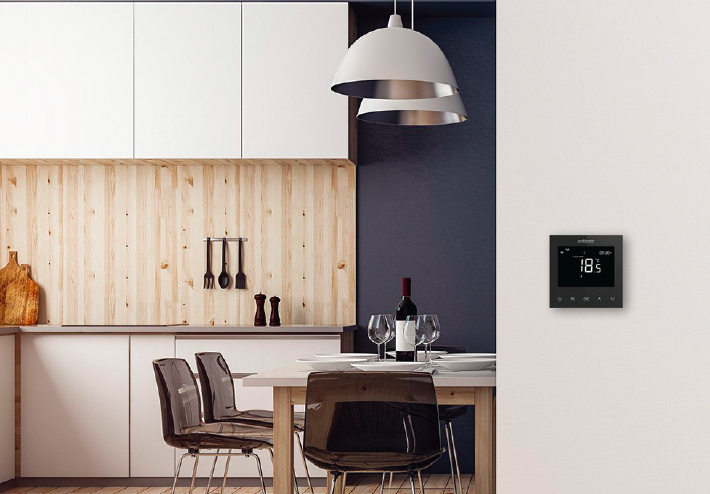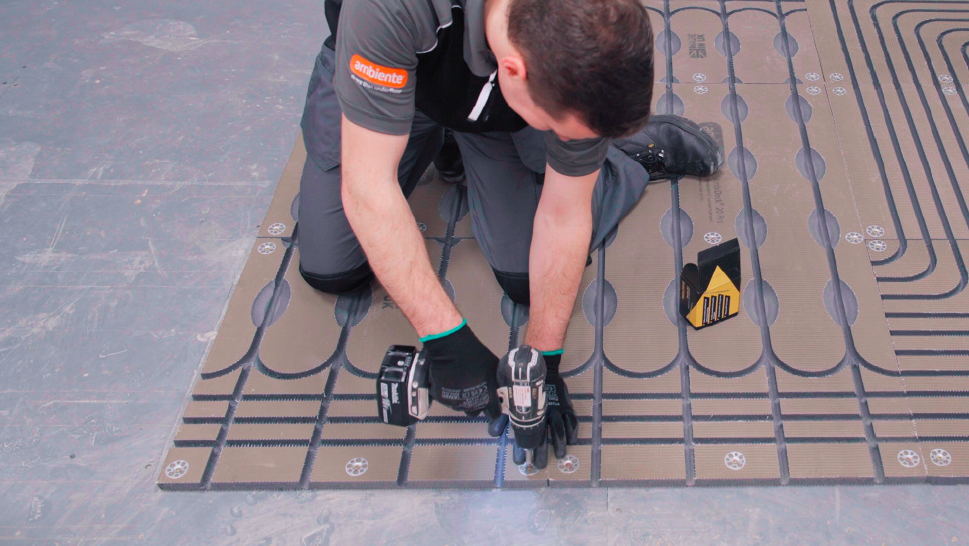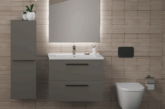
Carson Remmington, Ambiente’s Business Development Manager, provides an overview of how hydronic (water-based) underfloor heating enables more flexible and efficient use of the interior layout by freeing up wall space and how this trusted technology reduces environmental impact.
Maximising internal space
Reflecting the ongoing desire for more connected and versatile living environments, open or broken-plan living spaces remain a popular choice. They have redefined how homeowners interact with their homes, often merging cooking, dining, and relaxation areas into one seamless space. While heating systems and floor plans are usually only discussed in relation to heating zones for thermostats and controls, the conversation about heat emitter selection and the benefits underfloor heating offers is hotting up.
Underfloor heating removes the visual and spatial limitations imposed by wallhung emitters. Everything is hidden beneath the floor covering, allowing features such as open-plan areas and on trend floor-to-ceiling windows to be embraced. Clear wall spaces also provide complete freedom to position furniture, fixtures, and fittings without constraints, making it easier to optimise room layouts and create functional, stylish living spaces, especially within more compact homes.
Floor covering freedom
Adding to the flexibility and freedom underfloor heating provides, hydronic systems are compatible with most floor covering choices, even carpets. The key is to ensure that the finish is factored in at the very beginning of the system design, together with other key parameters.
This approach ensures the chosen floor covering doesn’t adversely affect the output of the final underfloor heating system, allowing the two elements to complement each other to maximise system efficiency. This is especially important when the floor finish will vary from room to room, such as carpet in the living room and natural stone in the kitchen.
Understanding the floor covering(s) thermal resistance factors will ensure the underfloor heating system design factors in the required spacing of the pipework and the rate at which the water will need to be pumped around the loops to meet the heat loss.
While almost every floor covering is compatible, ceramics and natural stone are the most popular choices to pair with underfloor heating. This is mainly due to the density of the materials and, subsequently, low thermal resistance, which allows the heat from the pipework to travel quickly through and heat the space above. The whole floor essentially becomes a big radiator, meaning naturally cold finishes such as stone become comfortably warm underfoot.
Underfloor heating reduces a property’s impact on the environment and significantly improves indoor air quality, making it easy to incorporate health and well-being into the fabric of the building.
Underfloor heating delivers heat differently from traditional convection (radiator) systems. It particularly benefits those with allergies and asthma. Underfloor heating actively reduces the movement of dust by utilising radiant heat, making it one of the healthiest ways to heat a property.
When heat radiates from the whole floor surface, it also eliminates cold spots from a room where mould could develop, ensuring that interior finishes remain in the very best condition and further reducing the impact on anyone suffering from a respiratory condition. Underfloor heating is the ultimate solution to create a future-proof heating system, from ensuring regs are met and energy bills are controlled to creating a luxuriously comfortable and healthy environment.
Meet the Building Regs with ease
Hydronic underfloor heating promotes energy efficiency through low-temperature heating, aligning with Part L of the Building Regulations and the proposed upcoming standards. It helps meet sustainability targets while maintaining comfort. By design, underfloor heating systems integrate smoothly with air and ground source heat pumps, as well as solar thermal systems, ensuring efficient operation and ticking all regulatory boxes without compromising thermal comfort.
These renewable heat sources typically produce much lower flow temperatures than standard gas or oil boilers. So, when paired with the most suitable heat emitters, the lower flow temperatures translate to savings on energy and overall heating costs.
Underfloor heating is also set up to meet the proposed demands of incoming standards and the already enforced Part L regulations for newly built homes and large-scale refurbishment projects. As underfloor heating covers a larger surface area, when well designed, these systems excel in energy efficiency by operating at a lower temperature of 35-40°C compared to the 80°C required by traditional radiators. This lower operating temperature improves efficiency and results in substantial energy savings for occupants. So, seamlessly integrating warmth into the home’s structure, hydronic underfloor heating elevates comfort and opens up endless possibilities for stylish, efficient and functional interiors.










